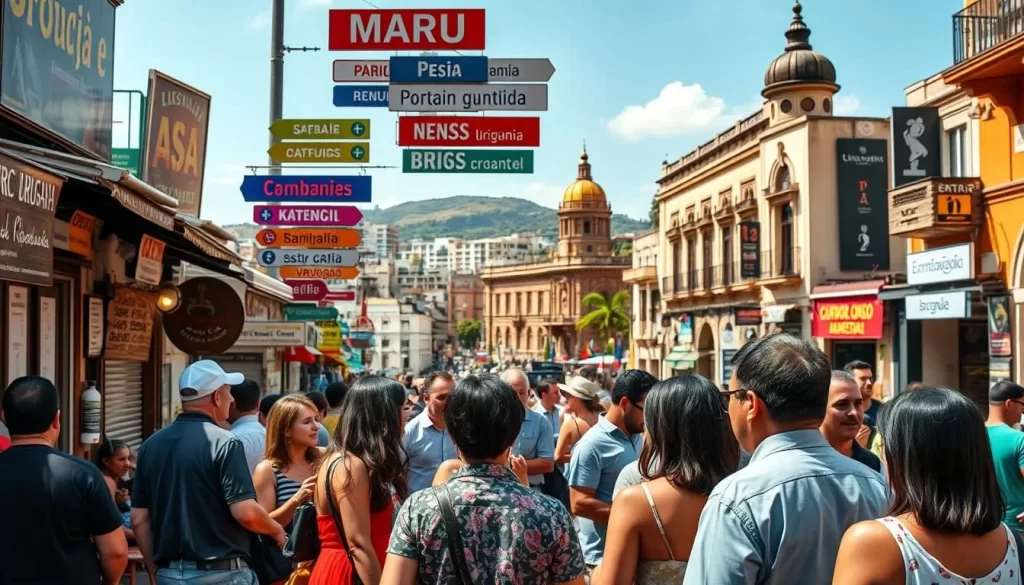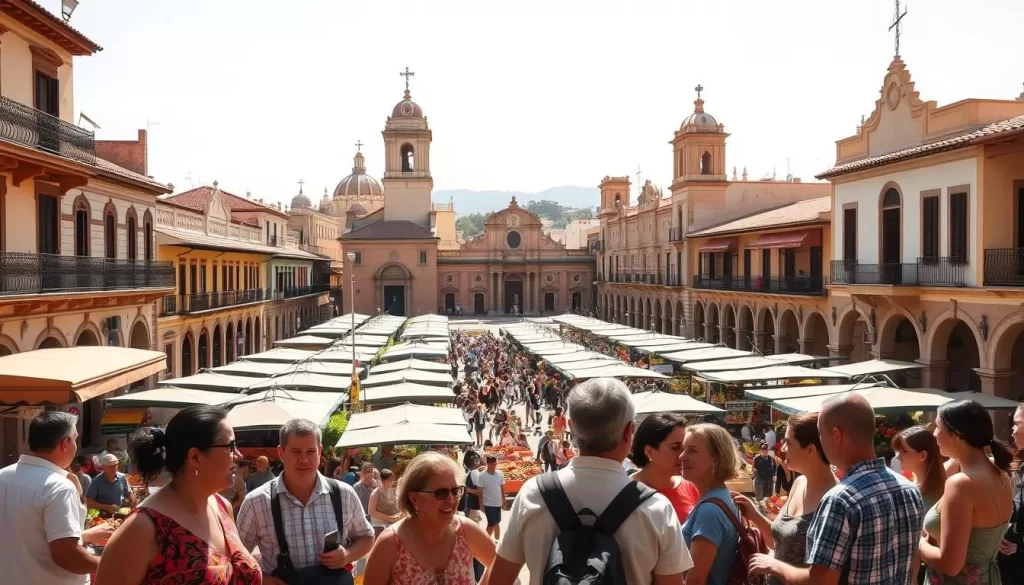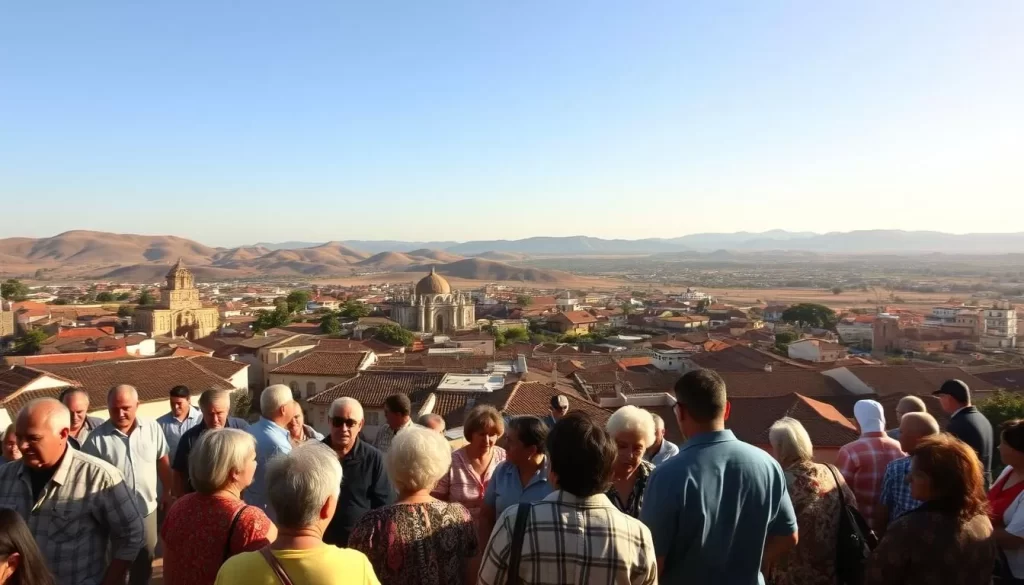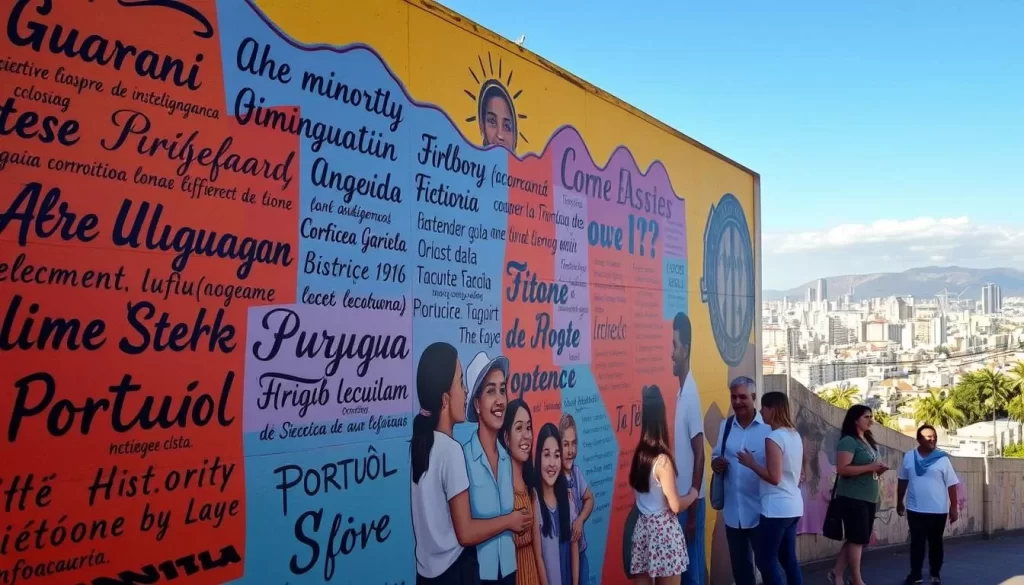✓ Accommodations✓ Flights✓ Rental Cars✓ Tours & Activities
When you think of a country with a rich cultural tapestry, one name often comes to mind. This South American nation is known for its vibrant history and diverse population. Spanish is the primary language here, spoken by nearly everyone in the community. With a population of over 3.4 million, this country’s linguistic identity has been shaped by waves of European migration.
In the north, you’ll find influences from neighboring regions, adding unique flavors to the local dialect. Words and phrases often carry a distinct charm, reflecting the country’s heritage. For example, the term “gurises” is used to refer to children, a word that’s deeply rooted in the local culture.
This section sets the stage for understanding how history and migration have shaped the language. As you read on, you’ll discover more about the fascinating linguistic trends that define this country.
Overview of Uruguay’s Linguistic Landscape
Exploring the linguistic diversity of a small nation reveals fascinating cultural layers. This South American country boasts a unique mix of languages and dialects, shaped by centuries of history and migration. From indigenous roots to European influences, the language landscape here is rich and varied.

Diversity of Languages in a Small Nation
Despite its size, this country is home to a vibrant linguistic tapestry. Spanish dominates as the primary language, but other dialects and influences add depth. For example, Portuguese is spoken along the border, reflecting regional ties.
Indigenous languages, though less prevalent today, have left their mark. Words and phrases from the Charrúa people still echo in everyday speech. This blend of languages highlights the nation’s cultural richness.
Historical and Demographic Insights
The population’s European ancestry, over 87.7%, has significantly shaped the language mix. Waves of Spanish and Italian settlers arrived in the 19th century, bringing their dialects and traditions. These migrations created a unique linguistic identity.
Over time, demographic shifts have influenced the way people speak. Urban areas, where 85.6% of the population resides, often have distinct dialects compared to rural regions. This contrast adds another layer to the country’s linguistic diversity.
Understanding this nation’s language requires a look into its past. From indigenous roots to European settlements, each era has left its mark. Today, the language reflects a blend of history, culture, and identity.
Uruguay: Official and widely spoken languages
Understanding the linguistic identity of a nation often starts with its primary language. In this South American country, Spanish dominates as the official language, spoken by nearly 99% of the population. This widespread use reflects centuries of cultural and historical influences.

The Role of Spanish as the National Language
Spanish is more than just a means of communication here; it’s a cornerstone of national identity. The dialect spoken in this country is softer than Castilian Spanish, influenced heavily by Italian immigrants. Words like “chau,” borrowed from Italian, are commonly used in everyday speech.
Over time, the language has evolved, blending local nuances with European roots. This unique mix makes the Spanish spoken here distinct from other regions. It’s a living testament to the country’s rich cultural heritage.
Influence of European Settlers on Language
European settlers, primarily from Spain and Italy, began arriving in the 18th century. Their dialects and traditions left a lasting mark on the local language. For example, the Italian influence is evident in the softening of certain Spanish sounds.
Today, over 87.7% of the population claims European ancestry, which continues to shape the linguistic landscape. This blend of history and culture has created a language that is both unique and deeply rooted in tradition.
“Language is the road map of a culture. It tells you where its people come from and where they are going.”
From the adoption of foreign words to the development of local dialects, the language here is a reflection of the country’s diverse history. It’s a fascinating journey through time, shaped by migration, culture, and identity.
Regional Languages and Dialects in Uruguay
The regional languages and dialects of this South American country paint a vivid picture of its cultural diversity. From the northern border to the bustling cities, each area has its own linguistic flavor. This section explores how geography and history have shaped the way people communicate.

Uruguayan Portuguese Along the Border
Near the Brazilian border, a unique mix of Portuguese and Spanish, often called portuñol, is commonly spoken. This blend reflects the close ties between the two countries. Around 2% of the population uses this dialect, especially in the northern regions.
The influence of Brazilian Portuguese is evident in everyday conversations. Words and phrases often borrow from both languages, creating a distinct linguistic identity. This cross-border exchange highlights the region’s cultural interconnectedness.
Variations in Dialect Across Regions
In the north, dialects tend to have a stronger Portuguese influence. Meanwhile, urban areas like Montevideo feature a softer, Italian-influenced Spanish. These variations make the language spoken here unique.
Over time, these regional differences have become a defining feature of the country’s linguistic landscape. Whether in the countryside or the city, each region offers a fresh perspective on how Spanish spoken here has evolved.
Minority and Historical Languages of Uruguay
The cultural fabric of this South American nation is woven with threads of diverse linguistic traditions. Beyond Spanish, the language landscape here includes minority tongues brought by immigrant communities. These languages reflect the country’s history of migration and cultural exchange over different centuries.

Languages of Immigrant Communities
Immigrant groups have left a lasting mark on the country. Italian, German, Catalan, Yiddish, and Plautdietsch are among the minority languages spoken today. These languages arrived with waves of European settlers in the 19th and 20th centuries.
For example, Italian is still heard in certain communities, especially in urban areas. German and Yiddish are preserved by descendants of European immigrants. These languages add depth to the nation’s cultural heritage.
Historical Lingual Influences That Shaped Today
Historical events have significantly influenced the language profile of this nation. During the 19th century, European migration patterns brought new dialects and traditions. Over time, these influences blended with local speech, creating a unique linguistic identity.
For instance, the arrival of Italian immigrants softened the Spanish spoken here. Words like “chau” (goodbye) became part of everyday speech. This blend of history and culture continues to shape the way people communicate today.
To learn more about the evolution of minority languages, explore this detailed resource.
Cultural Influences on Language in Uruguay
The way people speak often reflects their cultural roots and traditions. In this South American nation, the language has been shaped by a mix of historical events and regional customs. From the legendary gaucho culture to the unique slang used today, each element adds depth to the linguistic landscape.
The Impact of Gaucho Culture on Everyday Speech
The gaucho tradition, deeply rooted in rural life, has left a lasting mark on the way people communicate. Words like “mate” (a traditional drink) and “asado” (barbecue) are staples in everyday conversations. These terms are more than just vocabulary; they reflect a way of life that has shaped the country‘s identity.
Gaucho expressions often carry a sense of pride and resilience. For example, the phrase “echar la culpa” (to blame someone) is used with a unique flair, reflecting the gaucho’s straightforward nature. This cultural influence continues to enrich the dialect spoken here.
Local Slang and the Legacy of Cocoliche
Local slang is another fascinating aspect of the language. Words like “boludo” (a term of endearment or insult, depending on context) are widely used. This slang reflects the playful and expressive nature of the population.
One of the most intriguing linguistic legacies is Cocoliche, a dialect once spoken by Italian immigrants. Although it has faded over time, its influence can still be heard in certain phrases and intonations. For instance, the Italian word “chau” (goodbye) is commonly used today.
“Language is the mirror of a culture, reflecting its history, values, and identity.”
These cultural elements have created a unique linguistic identity. From the gaucho’s rugged expressions to the playful slang of urban areas, each layer adds richness to the way people communicate. To explore more about the evolution of local dialects, check out this detailed resource.
| Cultural Influence | Linguistic Impact |
|---|---|
| Gaucho Tradition | Words like “mate” and “asado” |
| Local Slang | Terms like “boludo” and “chau” |
| Cocoliche Dialect | Italian-influenced phrases |
Conclusion
The evolution of language in this South American nation tells a story of cultural fusion and historical depth. Spanish, as the official language, remains central to its identity, shaped by centuries of European influence. From Italian settlers to Portuguese-speaking border regions, each wave of migration has left its mark.
Today, the community reflects a blend of traditions, with regional dialects adding unique flavors. For example, the northern areas showcase a mix of Spanish and Portuguese, while urban centers retain softer, Italian-infused accents. This diversity highlights the nation’s rich heritage.
Over the years, demographic shifts have further enriched the linguistic landscape. With 87% of the population claiming European ancestry, the language continues to evolve. To explore more about this fascinating journey, visit this detailed resource.
In every word and dialect, the region’s history comes alive. From the gaucho traditions to modern slang, the language remains a testament to its vibrant past and dynamic present.
The above is subject to change.
Check back often to TRAVEL.COM for the latest travel tips and deals.






